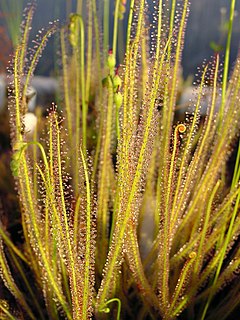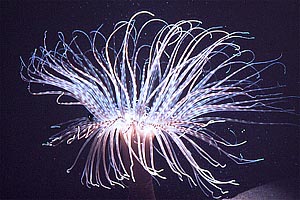
Aporphine is an alkaloid that forms the core of a class of quinoline alkaloids. It can exist in either of two enantiomeric forms, (R)-aporphine and (S)-aporphine.

Drosera filiformis, commonly known as the thread-leaved sundew, is a small, insectivorous, rosette-forming species of perennial herb. A species of sundew, it is unusual within its genus in that the long, erect, filiform (thread-like) leaves of this plant unroll in spirals – an arrangement similar to the circinate vernation seen in ferns.

Persicaria filiformis is a species of flowering plant in the family Polygonaceae, native to the Kuril Islands, Japan, Korea, Myanmar, the Philippines and Vietnam. It was first described as Polygonum filiforme in 1784 by Carl Thunberg and transferred to the genus Persicaria in 1819 by Takenoshin Nakai. The species has been treated as the variety filiformis of Persicaria virginiana, a North American species.
Androsace filiformis is a species of flowering plant in the primrose family known by the common names filiform rockjasmine and slender-stemmed androsace.

Muhlenbergia filiformis, known by the common name pullup muhly, is a species of grass. It is native to western North America from western Canada through the Western United States to northern Mexico.
Larinus filiformis is a species of true weevil found in Armenia, Azerbaijan, Turkey, and Bulgaria.

Veronica filiformis is a species of flowering plant in the genus Veronica. It is known by many common names, including slender speedwell, creeping speedwell, threadstalk speedwell and Whetzel weed. It is native to eastern Europe and western Asia, and it is known in many other regions as an introduced species.

Physaria filiformis is a rare species of flowering plant in the mustard family known by the common names Missouri bladderpod and limestone glade bladderpod. It is native to Missouri and Arkansas in the United States. It was federally listed as an endangered species in 1987 and it was downlisted to threatened status in 2003.

Cassytha filiformis, common name love-vine, is a species of obligate parasitic vine in the family Lauraceae. The species has a native pantropical distribution encompassing the Americas, Indomalaya, Australasia, Polynesia and tropical Africa In the Caribbean region, it is one of several plants known as "Love vine" because it has a reputation as an aphrodisiac.
Copelatus filiformis is a species of diving beetle. It is part of the genus Copelatus of the subfamily Copelatinae and the family Dytiscidae. It was described by Sharp in 1882.

Lomandra filiformis, commonly known as wattle mat-rush, is a tussock forming perennial herb that is native to Australia. It is sparsely tufted, with strap-like leaves and yellow flowers. It grows in dry sclerophyll forest and grassy woodland, usually on well-drained rocky or sandy soils.

Festuca filiformis, known by the common names fine-leaf sheep fescue, fine-leaved sheep's-fescue, hair fescue, and slender fescue, is a species of grass. It is native to Europe and it is widespread elsewhere as an introduced species and often a weed.
Amphiura filiformis is a species of brittle star belonging to the family Amphiuridae. It is found on the seabed in the north east Atlantic Ocean and adjoining seas to a depth of 200 metres (660 ft). It digs itself a shallow burrow in the sand and waves its arms in the water above to suspension feed on plankton.

Cerianthus filiformis is a species of tube-dwelling sea anemone in the family Cerianthidae.
Sagittaria filiformis, the threadleaf arrowhead, is an aquatic plant species native to the eastern United States, from Maine south to Florida and Alabama. it occurs in flowing streams in the northern part of its range, but more stagnant waters such as marshes and swamps in the South.

Sybra is a genus of beetles in the family Cerambycidae, containing the following species:

Sybra ordinata is a species of beetle in the family Cerambycidae. It was described by Bates in 1873.
Gagea filiformis is an Asian species of plants in the lily family, native to Russia, China (Xinjiang), Kazakhstan, Kyrgyzstan, Tajikistan, Uzbekistan, Afghanistan, Pakistan, and Mongolia.

Persoonia filiformis is a shrub native to Western Australia.

Leptinella filiformis, or slender button daisy, is a species of flowering plant in the daisy family, found only in the north-eastern part of the South Island of New Zealand. Thought to be extinct by the 1980s, it was rediscovered growing on a hotel lawn in 1998, and in the wild in 2015.















